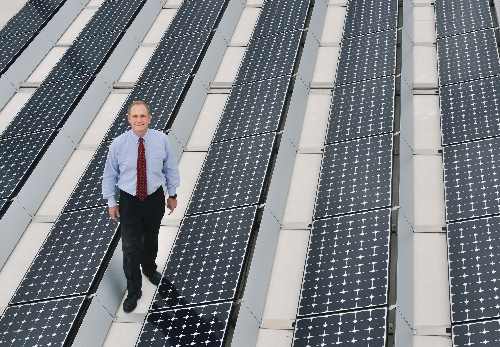Green projects proving worthy


Green building, the term coined to describe ecofriendly, sustainable construction, is spreading like wildfire. Government agencies and businesses are increasingly realizing green building’s myriad benefits for worker recruitment and retention, productivity and job satisfaction.
Sure, green building is a feel-good thing to do. But it also saves money. It emphasizes quality construction and conservation for more energy-efficient homes and offices, shops and warehouses.
Green building can lower overhead costs through reduced power and water bills; it’s the type of thing that companies value, especially during a recession.
"People are increasingly realizing benefits of green building in terms of the energy savings," said Deepika Padam, 2010 president of the Las Vegas chapter of the American Institute of Architects. "More than ever, people want to save money wherever they can."
Today’s most popular framework for green building is LEED — an acronym for Leadership in Energy and Environmental Design. The U.S. Green Building Council, a Washington, D.C.-based nonprofit trade group, created the system in 2000 to help promote, instruct and evaluate sustainability. LEED works like a report card: Points are awarded for air quality, recycling and energy efficiency, among other measures. The more points, the higher the grades, which go from basic certification to silver, gold and platinum (the equivalent of an A plus). Several LEED projects now dot Southern Nevada’s landscape.
KLVX-TV, Channel 10, aka Vegas PBS, for instance, moved into its new $42 million gold-LEED-certified headquarters last year. The 108,000-square-foot building on 10 acres uses 35 percent less energy than a traditional building of similar size. Photovoltaic panels generate 18.4 percent of the building’s electricity on site. There are also geothermal wells that cool air-conditioning water, and underground cisterns to collect rainwater. Martin-Harris Construction was the contractor; JMA was the architect. The building at 3050 E. Flamingo Road creates a bottom-line savings that its nonprofit owner appreciates.
"In June, our electrical bill in this building was $9,000; the bill in our old building, which was one-quarter of the size, was $11,000. You do the math," KLVX General Manager Tom Axtell said. "This building clearly is a morale booster. It’s clean, airy and bright. There is a sense that it’s a good place to work. It reduced employee sick days."
The city of Las Vegas is building a new City Hall that strives for silver LEED certification. The eight-story, 308,990-square-foot building, developed by Forest City Enterprises, includes an outdoor plaza along Clark Street with free-standing photovoltaic trees that double as shade awnings. There are additional solar panels on the rooftop, as well as other sustainable building features. JMA is the architect; Whiting-Turner Contracting Co. is the contractor.
The new facility reduces energy costs by more than $500,000 annually and avoids $1.5 million in new-equipment expenses needed to renovate the existing 37-year-old City Hall.
"We don’t have any clients that don’t want a sustainable building. It has now become a common practice," JMA President Thomas Schoeman said. "The city wants to be a sustainable-oriented public agency. I think it’s important to them because public buildings make a statement about where you live."
More than one in five U.S. cities with 50,000 residents or more have a policy to promote green building, according to a new American Institute of Architects survey. The city of Las Vegas and Henderson have sustainable building policies in place, as do the state of Nevada and Clark County.
One hundred thirty-eight cities have green building programs, or 50 percent more than three years ago. Las Vegas implemented a citywide green building program in 2007 that requires new building projects to meet a minimum silver LEED certification standard. The city also offers incentives, such as vouchers that can be applied toward reducing permitting fees and expediting plans checks, to private developers that pursue green building.
"The mayor and city council want Las Vegas to be known as a sustainability leader," said Tom Perrigo, the city of Las Vegas’ deputy director of planning and development. "It creates jobs, saves money and reduces the carbon footprint."
As companies tighten their belts during the downturn, green building is expected to triple in volume by 2013, reaching up to $140 billion annually in construction spending, McGraw-Hill’s Construction Group reports. Much of the green spending will occur with retrofits and renovations since many buildings are aging and inefficient, McGraw-Hill reported. Green building now comprises only 5 percent to 9 percent of the market, but could reach 30 percent within the next five years, the company said.
"The green building market has basically tripled for the last two years, which is a good sign that it’s flourishing. Developers and owners are seeing the value in green building as a competitive differentiator," said Rick Van Diepen, 2010 president of the U.S. Green Building Council’s Nevada chapter. "The bottom-line decisions are becoming paramount in terms of lowering operating costs. People are beginning to understand the benefits more and more."
In 2005, state lawmakers created another green benefit with passage of Assembly Bill 3, which gives property and sales tax abatement for LEED projects. The level of savings depends upon the certification level and building type. But the tax incentives can last for up to a decade. Proponents say the legislation boosted public awareness of green building.
"AB3 was very cutting-edge at the time. Nevada, as a state, was the nation’s leader in green building incentives," said Pamela Vilkin, president of Greenview LLC, a Las Vegas-based sustainability consultant. "I think it helped jump-start the industry."
Creating a green environment doesn’t necessarily require new construction or even a significant investment. It can be as simple as replacing light bulbs. Compact fluorescent lights can save over $30 in electrical costs versus incandescent lamps.
"There are simple strategies for lowering operating costs. You can change out plumbing fixtures with low-flow alternatives or install a digital programmable thermostat," Lucchesi, Galati Architects Principal Craig Galati said. "Small things can sometimes make a big difference."
Contact reporter Tony Illia at tonyillia@aol.com or 702-303-5699.












